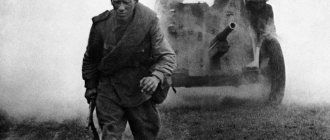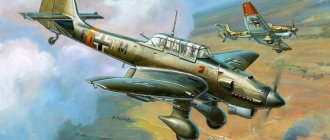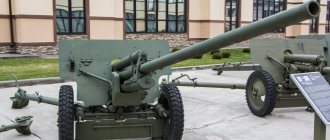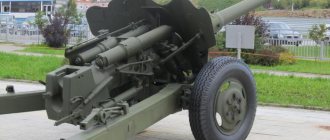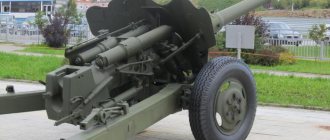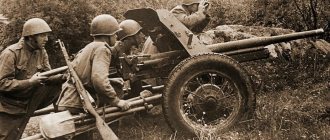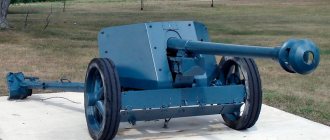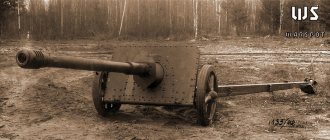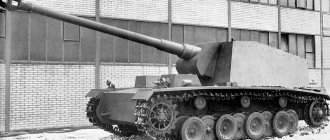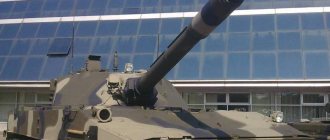Tanks take to the battlefields
Any war stimulates the emergence of new types of weapons and military equipment, since they can give one of the parties to the conflict an advantage over the other, but the First World War stands apart in this regard. During it, not only completely new types of weapons and equipment appeared on the battlefields, but also new types of troops, such as the air force and armored units. The reason for the emergence of new types of weapons was that in that war, the confrontation between millions of armies of dozens of countries, despite the enormous human sacrifices, reached a dead end and the fighting entered a positional phase, creating a stalemate.
In this regard, military specialists on the warring sides feverishly searched for new and unusual weapons capable of making the fronts move again. Chemical weapons are adopted and Germany is the first to use them. Airships and airplanes are widely used, and for the first time, on September 15, 1916, the British throw into battle a new type of combat vehicle - the world's first tank. German positions were attacked in France on the Somme River by English tanks of the Magk I model. Their effectiveness turned out to be so high that almost all countries had an urgent need to create special anti-tank weapons. And such work began on both sides of the front line.
At the first stage, the military tried to use existing weapons to fight tanks - field artillery, powerful small arms, hand grenades and homemade mines based on standard artillery shells. But all of them showed low efficiency. Therefore, very soon the German army issued technical specifications to arms companies to develop special anti-tank defense systems. Already at the end of 1916, German industry began producing anti-tank mines, of which about 3 million were produced. True, the use of mines to combat tanks had a number of disadvantages: for greater efficiency and reliable protection of troops from attacks by armored vehicles, mines had to be installed in continuous minefields in tank-hazardous directions; the installation was carried out by sappers manually under enemy fire, which led to heavy losses. The creation of minefields required large material and physical costs; the tank was blown up by a mine, usually near the trenches, while the crew and weapons remained unhit, and the crew continued to fire from the stationary vehicle.
The armies needed anti-tank weapons capable of effectively hitting a tank at a sufficiently large distance from forward positions. The Germans again found a way out - at the end of the war, Rheinmetall developed and offered the army a light anti-tank gun PAK 35/18, which penetrated 15-mm armor at an angle of 90 degrees at a range of 500 meters.
The necessary technical characteristics of an anti-tank gun of this period, included in the terms of reference, were formed on the basis of an analysis of existing and promising enemy armored vehicles, such as the British Mark IV, Mark V and Mark A (2800 copies were manufactured), French Schneider CA1 tanks, Saint Chamond and Renault FT-17 (5,300 copies produced). The US industry produced European tanks under license, but with American engines: French - model Renault FT-17 and English models - Mark V and Mark VIII" (1000 copies were produced).
—
Tactical and technical characteristics of the RAK 35/36 anti-tank gun
| — Caliber | 37 |
| — Initial projectile speed, m/s | 760 |
| Firing range | |
| - - effective | 500 |
| — — maximum | 7000 |
| Armor penetration at a range of 365 m, mm | 38 |
| — Pointing angles, degrees. — | |
| - - along the horizon | 59 |
| - - vertically | (-8)…(+25) |
| — System weight, kg — | |
| - - in combat position | 328 |
| - - on the move | 440 |
| Projectile mass, kg — | |
| - - armor-piercing | 0,354 |
| - - high-explosive fragmentation | 0,625 |
| Length, mm — | |
| - - guns | 1665 |
| - - trunk | 1308 |
Ammunition 3.7 cm Pak 36 L/45 [edit]
| This section may contain original research . |
Pzgr
- Projectile mass
: 0.685 kg - Muzzle velocity
: 745 m/s
Pzgr 40
This was a type of tungsten core ammunition, lighter and with a higher muzzle velocity, produced in small quantities.
- Projectile mass
: 0.368 kg - velocity
: 1020 m/s
Probability of hitting a target 2.5 x 2 m [9]
| Classify | Penetration | in teaching | in battle |
| 100 m | 64 mm | 100% | 100% |
| 500 m | 31 mm | 100% | 100% |
| 1000 m | 22 mm | 100% | 85% |
| 1500 m | 20 mm | 95% | 61% |
| 2000 m | - mm | 85% | 43% |
Armor penetration indicators are given for Pzgr 40 and armor plate at 30 degrees from the horizontal.
Stielgranate 41[edit]
Pak 36 with Stielgranate 41
, which was used in the later stages of World War II.
In 1943, the introduction of the Stielgranate 41 shaped charge [10] meant that the Pak 36 could now penetrate most armor, although the low velocity of the projectile limited its range. Pak 36s, along with new shaped charges, were issued to Fallschirmjäger units and other lightly equipped troops. The gun's light weight meant that it could be easily moved by hand, and this mobility made it ideal for their purposes.
37 mm anti-tank
The tanks of the First World War had weak armor and protected the crew only from shell fragments and small arms bullets. But already in the 20s. Combat vehicles with more powerful armor began to be created, which necessitated the modernization of the 37-mm anti-tank gun in service with the Reichswehr.
In 1925, Pheinmetall created a practically new 37-mm anti-tank gun, mass production of which began in 1928. The gun was equipped with a shield mounted at a large angle of inclination, tubular legs of the frames extended over a long distance, and wheels with spokes. The gun was towed by horse-drawn vehicles. In 1934, the developer modernized this model to convert it to mechanical traction: spoked wheels were replaced with wheels with steel rims and pneumatic tires. This artillery system received the official name Panzerabwehrkanone 35/36 (PAK 35/36) and was adopted by the German army.
The main targets on the battlefield for the Pak 35/36 gun were lightly armored combat vehicles, unarmored vehicles and manpower. To solve these problems, the system's combat kit included ammunition with fragmentation tracer, armor-piercing tracer, armor-piercing tracer sub-caliber and practical armor-piercing tracer projectiles.
—
Tactical and technical characteristics of cartridges for the 37-mm anti-tank gun Rak 35/36
| Chuck type/ Characteristics | High-explosive fragmentation model 18 | Fragmentation tracer sample 4 | Armor-piercing tracer | Armor-piercing tracer sub-caliber |
| Weight, kg | ||||
| - cartridge | 1,385 | 1,305 | — | — |
| - powder charge | 0,175 | 0,175 | — | — |
| Igniter | 0,002 | 0,002 | 0,002 | 0,002 |
| Length, mm | ||||
| - cartridge | 341,5 | 337,0 | 337,0 | 337,0 |
| - sleeves | 250,0 | 250,0 | 250,0 | 250,0 |
| flange diameter , mm | 51,5 | 51,5 | 51,5 | 51,5 |
FOREIGN-MADE ANTI-TANK GUNS
FOREIGN-MADE ANTI-TANK GUNS
In addition to anti-tank guns developed and manufactured in Germany, the Wehrmacht troops used a large number of foreign-made artillery systems. First of all, these are weapons that were inherited after the Anschluss of Austria and the annexation of Czechoslovakia to the Reich. Then captured Polish, French, English, Belgian and Soviet guns captured by the Germans during the campaigns of 1939–1943. Of course, the scale of use of these guns was small, but in general they amount to several thousand barrels. Like other captured equipment, anti-tank guns received their own designations when they entered service with the Wehrmacht. Further, these artillery systems are considered in the chronological sequence of their entry into service with the Wehrmacht.
47-mm Austrian anti-tank gun - 4.7-cm Pak 35/36 (o) (4.7-cm Panzerabwehrkanone 35/36 (?))
The gun was developed by the Bohler Brothers company in the city of Kapfenberg and was adopted by the Austrian army in 1935 as the 47 mm Bohler Modell 1935 gun. In total, 353 such artillery systems were manufactured before the Anschluss of Austria in March 1938. The gun weighing 315 kg had in its ammunition unitary rounds with armor-piercing (weight 1.44 kg) and fragmentation (weight 2.37 kg) shells. The barrel was mounted on a carriage with two sliding frames; the gun had no shield. For transportation there were two small wheels with pneumatic tires that could be removed. In this case, the gun rested on the ground with frames and a special support, which folded forward during transportation.
The Germans adopted this weapon under the designation 4.7 cm Panzerabwehrkanone 35/36 (?) or 4.7 cm Pak 35/36 (?) - “4.7 cm anti-tank gun model 1935/36 (Austrian) " 330 of these guns were transferred to the troops, and another 150 were assembled in 1940 by the Bohler company from the existing stock. Pak 35/36 (?) was used to a limited extent by the Wehrmacht until the beginning of 1942 in North Africa and on the Soviet-German front, a number were transferred to the Romanians.
In 1935, Austria sold a license for the production of these guns to Italy, where they were modified and put into service under the designation Cannon anticarro 47/32 modello 35. The gun differed from the Austrian original in the absence of a muzzle brake, different wheels and a slightly modified frame design. After the surrender of Italy in 1944, a small number of these guns were used by the Wehrmacht under the designation 4.7-cm Pak 1.77 (i).
Soldiers of one of the police units at their guns: 47-mm Italian anti-tank Pak 177 (i) (left) and 45-mm Soviet Pak 184 (r). The difference between the Italian gun and its Austrian counterpart is the absence of a muzzle brake.
Soviet soldiers keep records of captured property captured northwest of Stalingrad. December 1942. In the foreground is a 47 mm Austrian Bohler anti-tank gun model 1935. The Germans handed over a certain number of such guns to the Romanians, and during the defeat of whose units at Stalingrad, this gun was captured by units of the Red Army (ASKM).
Tactical and technical data of the Austrian 47-mm anti-tank gun Pak 35/36 (?).
37-mm Czechoslovak anti-tank gun PUV vz.37-3.7-cm PakM 37(t) (3.7-cm Panzerabwehrkanone M 37(t))
The gun was developed by Skoda in 1935–1936 and adopted by the Czechoslovak Army under the designation PUV vz.37 (1937 model anti-tank gun).
In terms of its design, this weapon was quite advanced for its time. It had a monoblock barrel with a horizontal wedge bolt, which ensured a rate of fire of up to 20 rounds per minute. The barrel, upper mounting and sighting devices were mounted on a carriage with frames that were sliding when firing. The cannon had wooden spoked wheels that were sprung, so it could be transported not only by horses, but also by mechanical traction. To protect the gun crew from bullets and shell fragments, a shield of 5 mm armor was used. In addition, this gun had an unusual feature for its time - for transportation, the barrel was rotated 180 degrees and attached to the frame.
For firing from the PUV vz.37, two types of unitary shots were used: with an armor-piercing projectile weighing 0.85 kg and a 1.2 kg fragmentation projectile.
Pak M 37 (t) crew at the firing line. Unlike the gun in photo 72, this gun has wheels with pneumatic tires, which made it possible to increase the speed of its transportation using mechanical traction (ASKM).
By the time of the occupation of Czechoslovakia by Germany (March 1939), 1,724 37-mm anti-tank guns had been manufactured. The Germans, appreciating the good combat qualities of the gun, adopted it for service under the designation 3.7-cm Panzerabwehrkanone M 37(t) - “3.7-cm anti-tank gun model 1937 (Czechoslovak)” or abbreviated 3.7-cm Pak M 37(t). Its production continued in 1939 (277 pieces were produced) and in January-May 1940 (236 pieces), after which it was discontinued. Guns manufactured in 1939–1940 received wheels with pneumatic tires, which made it possible to increase the speed of their transportation. In addition, such wheels were also installed on some guns of earlier production.
Pak M 37(t) entered service with tank destroyer battalions of infantry divisions and were used by troops until the beginning of 1942, after which they began to be replaced by more powerful anti-tank guns.
Even after the occupation of Czechoslovakia, the Skoda company continued to work on new anti-tank guns, now for the Wehrmacht. Thus, at the beginning of 1942, a prototype of a 37-mm gun was manufactured, designated Pak 39/40. It was a further development of the Pak M 37(t), but had a different carriage and a higher projectile speed. However, by this time, 37-mm anti-tank guns had proven to be ineffective against tanks with anti-ballistic armor, so after the production of a batch of 34 Pak 39/40s, all work on them was stopped. The author knows nothing about their fate.
Wehrmacht exercises - the crew deploys a 37-mm Pak M 37 (t) anti-tank gun. Autumn 1939 (IP).
Tactical and technical data of the 3 7-mm Pak M37(t) anti-tank gun.
47-mm Czechoslovak anti-tank gun PUV vz. 36-4.7-cm Pak 36(t) (4.7 cm Panzerabwehrkanone 36 (t))
This gun was developed by Skoda in 1935–1936 as a further development of the 37-mm anti-tank gun vz.37. It was adopted by the Czechoslovak army as the PUV vz.36 (anti-tank gun model 1936). Structurally and externally, the vz.36 was very similar to the 37 mm vz.37, differing from the latter in overall dimensions and weight (595 kg versus 364 kg). In addition, for compactness during transportation, both frames of the PUV vz.36 folded. The ammunition of the 47-mm anti-tank gun included unitary rounds with armor-piercing and fragmentation shells. The first, with a mass of 1.65 kg, had an initial speed of 775 m/s and penetrated 55 mm armor at a distance of 1000 m, the second had a mass of 1.5 kg.
Despite the fact that the 47-mm anti-tank gun was put into service earlier than the 37-mm, for a number of reasons its mass production began later. In total, before the occupation of Czechoslovakia by Germany, Skoda manufactured 775 47-mm PUV vz.36 anti-tank guns. A small number of these guns were sold to Yugoslavia in 1937–1938.
Like the 37-mm anti-tank gun, the PUV vz.36 entered service with the Wehrmacht under the designation 4.7-cm Panzerabwehrkanone 36(t) - “4.7-cm anti-tank gun model 1936 (Czechoslovakian)”, or 4.7- cm Pak 36(t). The Germans continued its production, and by the time production ceased at the beginning of 1942, another 487 guns had been manufactured. In 1941, the Germans introduced a sub-caliber projectile with a PzGr 40 tungsten carbide core into the Pak 36(t) ammunition load, which increased the armor penetration of the gun.
In 1939, the Pak 36(t) began to enter service with tank destroyer battalions of a number of infantry divisions and was first used during combat in France in 1940.
Since March 1940, the 47-mm Pak 36(t) began to be installed on the chassis of the Pz.l Ausf.B tank (202 vehicles were manufactured until February 1941), and from May 1941 - on the chassis of the captured French tank R-35 (up to October 1941, 174 vehicles were manufactured). Self-propelled guns, designated Panzerjager I and Panzerjager 35 R (f), respectively, entered service with tank destroyer divisions.
The 47-mm Pak 36(t) anti-tank gun was only slightly inferior in armor penetration to the 50-mm German Pak 38 and was used by the army until the beginning of 1943, after which it began to be replaced by the more powerful 75-mm Pak 40.
In 1940–1941, the Skoda company produced prototypes of more powerful guns of 50 and 66 mm caliber. The first, designated Pak 206/835, weighing 1,350 kg, was semi-automatic and had a tray for five shells. The second, designated Pak 5/800, had a mass of 2,050 kg and an initial armor-piercing projectile speed of 800 m/s. Both guns were tested, but did not enter service with the Wehrmacht, remaining only as prototypes.
The crew of the 47-mm Pak 36 (t) anti-tank gun during fire training classes. Spring 1940. On top of the shield are attached parts of a banner for cleaning the gun barrel. The camouflage may have been applied during the gun's service in the Czechoslovak Army (RGAKFD).
Climbing a 47 mm Pak 36 (t) anti-tank gun uphill. Yugoslavia, spring 1940. Like German anti-tank guns, Czechoslovak-made artillery systems included special cables that made it easier for the crew to transport the guns across the terrain manually (RGAKFD).
Tactical and technical data of the 47 mm Pak 36 (t) anti-tank gun.
37-mm Polish Bofors anti-tank gun - 3.7-cm Pak 36 (r) (3.7-cm Panzerabwebrkanone 36 (r))
The 37 mm anti-tank gun was developed by the Swedish company Bofors in 1934–1935 and was intended primarily for export. Among the countries interested in this weapon was Poland, which purchased a license for its production. In 1936, the gun entered service with the Polish army under the designation 37-mm armata przeciwpancerna wz.36 (37-mm anti-tank gun model 1936). A certain number of guns were purchased in Sweden, and then their production began in Poland. In total, by September 1939, 1,730 such guns were manufactured.
The wz.36 gun was quite advanced for its time. It had a monoblock barrel with a semi-automatic horizontal bolt, providing a rate of fire of up to 20 rounds per minute. The barrel was mounted on a carriage with sliding frames, on which there were places for two crew numbers. The gun had wheels with pneumatic tires, allowing it to be transported at speeds of up to 50 km/h. The crew was protected by a curved shield made of 5 mm armor, and its lower part could be hinged. The gun was equipped with a front end in which ammunition was transported. For firing from the wz.36, unitary shots with armor-piercing and fragmentation shells were used. The guns performed very well in the September 1939 battles with German tanks.
After the end of the Polish campaign, the Germans received a fairly large number of 37-mm wz.36 guns as trophies. Of these, 621 guns entered service with the Wehrmacht under the designation 3.7 cm Panzerabwebrkanone 36 (p) or 3.7 cm Pak 36 (p) - a 3.7 cm anti-tank gun of the 1936 model (Polish). They were used in infantry divisions, but at the end of 1941 they began to be withdrawn from the troops. However, judging by the photographs, a small number of Pak 36(r) were used by the Wehrmacht until the end of the war. In any case, about 20 such guns went to the Red Army as trophies during the surrender of the Courland group of Germans in May 1945.
37-mm Polish Bofors anti-tank gun, used by the Wehrmacht under the designation Pak 36 (p) (ASKM).
German crew of a 37-mm Pak 36 (r) anti-tank gun in a firing position. Soviet-German Front, 1943 (ASKM).
Polish-made 37-mm Pak 36(p) anti-tank guns in a German artillery park during the surrender of Army Group Kurland. May 1945. The photo shows at least 14 such guns (ASKM).
Tactical and technical data of the 37-mm anti-tank gun Pak 36 (p).
47-mm Belgian anti-tank gun SA.FRS - 4.7 cm Pak 185 (b) (4.7 cm Panzerabwebrkanone 185 (b))
The gun was developed by the Royal Artillery Factory in Liege and entered service with the Belgian Army in 1935 as a 47 mm anti-tank gun (Canon de 47 antichar SA.FRS). The gun had a monoblock barrel with a semi-automatic bolt, mounted on a massive riveted carriage with sliding frames. Two metal wheels with solid rubber were used to transport the gun, and a bent metal shield was used to protect the crew from bullets and shell fragments. The gun was produced in small quantities until the occupation of Belgium by Germany.
The captured 47-mm SA.FRS guns entered service with the Wehrmacht under the designation 4.7-cm Panzerabwebrkanone 185 (b) or Pak 185 (b). They were used to a limited extent by German occupation units in Belgium, as well as in coastal defense. The exact number of these guns available in the Wehrmacht service is unknown to the author.
Crew of a Belgian-made 47-mm Pak 185 (b) anti-tank gun at a firing position (IP).
German soldiers with captured Belgian SA.FRS anti-tank guns, later designated Pak 185 (b). 1940 (ASKM).
47-mm Belgian anti-tank gun SA.FRS, used in the Wehrmacht under the designation Pak 185 (b), rear right view (ASKM).
German soldiers inspect a captured Belgian SA.FRS anti-tank gun. 1940 (ASKM).
Tactical and technical data of the 47-mm anti-tank gun Pak 185 (b).
2-pounder (40 mm) British anti-tank gun QFMk.VII - 4-cm Pak 192 (a) (4-cm Panzerabwehrkanone 192 (a))
The gun was developed by the English Royal Ordnance Factory and adopted by the British Army in 1937. The gun was quite heavy - almost 800 kg, but thanks to the design of the carriage it had a circular fire along the horizon. To transport it, removable wheeled wheels were used. By the beginning of the Second World War, this weapon was the main anti-tank weapon of the British army. Its ammunition included only an armor-piercing projectile weighing 0.921 kg.
During the French campaign of 1940, during the defeat of the English Expeditionary Force at Dunkirk, the Wehrmacht received about 500 of these guns as trophies. They were adopted by the German army under the designation 4-cm Panzerabwehrkanone 192 (a) or 4-cm Pak 192 (a) - 40-mm anti-tank gun 192 (English). However, the use of these guns was quite limited - they mainly served in coastal defense on the Atlantic Wall. In total (according to various sources), the Germans used from 200 to 350 of these guns.
The Germans have a captured English 40-mm QFMk anti-tank gun. VII, which received the designation Pak 192 (a) in the Wehrmacht. France, 1940 (BA).
An English 40-mm QFMk.VII anti-tank gun abandoned near Dunkirk. France, 1940. The gun is in the stowed position, the folded forward rests (BA) are visible.
40-mm anti-tank gun Pak 192 (a) - English two-pounder QFMk.VII, shown in firing position on an unfolded carriage with the moves removed (IP).
A German artilleryman with a British 40-mm QFMk anti-tank gun. VII, designated Pak 192(a). The gun is in the stowed position, the stops are raised.
Tactical and technical data of the 40-mm anti-tank gun Pak 192 (a).
25-mm French anti-tank gun Hotchkiss model 1934 SA-L mle 34-2.5-cm Pak 112(0 (2.5-cm Panzerabwehrkanone 112 (f)
This gun was adopted by the French army in 1934 as the 25 mm anti-tank gun model 1934 (Canon leger de 25 antichar SA-L mle 1934). The monoblock barrel with a semi-automatic wedge bolt was mounted on a carriage with sliding frames. To protect the crew, the gun was equipped with a shield, and small wheels on pneumatic tires allowed it to be transported at speeds of up to 50 km/h. The ammunition included unitary rounds only with an armor-piercing projectile (blank) weighing 0.32 kg; there were no fragmentation rounds for this weapon. By the beginning of World War II, the French army had about 3,000 such guns.
During the French campaign of 1940, the Wehrmacht received several hundred 25-mm anti-tank guns of the 1934 model as trophies, many of them in full working order. The gun was adopted by the German army under the designation 2.5-cm Panzerabwehrkanone Pak 112 (f) or 2.5-cm Pak 112 (f). They were used to a limited extent as part of infantry divisions during battles on the Soviet-German front, in North Africa, as well as in coastal defense on the Atlantic Wall and in Norway. These guns were used until 1943, after which they began to be withdrawn from the troops.
German crew at the 25-mm Hotchkiss anti-tank gun model 1934 SA-L mle 34. France, June 1940. A small number of such captured guns were used by Wehrmacht units back in the French campaign of 1940 (ASKM).
25-mm Hotchkiss anti-tank gun model 1934 SA-L mle 34, which received the designation Pak 112 (f) (ASKM) in the Wehrmacht.
German crew of a 25-mm Pak 112 (f) anti-tank gun mounted on the fortifications of the Atlantic Wall. 1943 (YaM).
Tactical and technical data of the 25-mm anti-tank gun Pak 112 (f).
25-mm French anti-tank gun model 1937 - 2.5-cm Pak 113 (f) (2.5-cm Panzerabwebrkanone 113 (f)
Developed by Puteanz, the 25 mm anti-tank gun entered service with the French army at the end of 1937 as the 25 mm anti-tank gun model 1937 (Canon leger de 25 antichar SA-L mle 1937). It had a similar design to the 1934 model gun, but was almost 100 kg lighter. Ballistics-wise, both guns were similar. The MLE 1937 was fired using an armor-piercing projectile weighing 0.32 kg, the same as for the MLE 1934.
During the fighting in France, the Germans captured a large number of serviceable guns of the 1937 model and adopted them into service with the Wehrmacht as the 2.5-cm Panzerabwehrkanone Pak 113 (f) or 2.5-cm Pak 113 (f). These guns were used to a limited extent during the fighting in North Africa, as well as in coastal defense in France and Norway. The author is aware of a photograph of a Pak 113 (f) gun mounted on an Sd.Kfz.250 armored personnel carrier.
25-mm Hotchkiss a model 1937 anti-tank gun mle 37, designated Pak 113 (f) (ASKM) by the Wehrmacht.
German crew of a French-made 25-mm Pak 113 (f) anti-tank gun during an exercise. Norway, 1943 (YaM).
Exercises to repel a tank attack: the photo shows a French-made 25-mm Pak 113 (f) anti-tank gun. France, 1942. It is clearly visible that in the firing position the gun was hung using frames and an additional support (BA).
Tactical and technical data of the 25-mm anti-tank gun Pak 113 (f).
47-mm French anti-tank gun Schneider model 1937 - 4.7-cm Pak 181(f) (4.7-cm Panzerabwehrkanone 181(f)
The gun entered service with the French army in 1937 and was produced until June 1940. A total of 1,310 such artillery systems were manufactured. The gun had a monoblock barrel with a semi-automatic bolt, mounted on a carriage with sliding frames. The gun had a shield and metal sprung wheels with rubber tires for transportation. Its ammunition included unitary rounds only with an armor-piercing projectile (blank) weighing 1.725 kg.
During the French campaign, the Germans received a significant number of these guns in good condition, 823 of which entered service with the Wehrmacht under the designation 4.7-cm Panzerabwehrkanone 181(f) or Pak 181(f). In 1941, a number of these guns entered service with tank destroyer divisions of a number of infantry divisions operating on the Soviet-German front. Therefore, in the same year, the Germans introduced a PzGr 40 sub-caliber projectile weighing 0.8 kg into the Pak 181(f) ammunition, which made it possible to somehow fight Soviet tanks. True, very few such shells were manufactured. In 1942, the Pak 181(f) began to be withdrawn from the troops; subsequently they were used in training units and in divisions located in France. The Germans installed several of these guns on the chassis of captured French Lorraine tractors.
Exercises of the crew of the 47-mm Pak 181 (f) anti-tank gun (Schneider anti-tank gun model 1937) from the 56th Infantry Division. Spring 1941 (ASKM).
47-mm Pak 181 (f) anti-tank gun in a firing position. Summer 1941, Soviet-German front, presumably the 56th Infantry Division (ASKM).
Towing a 47mm Pak 181(f) anti-tank gun by truck. Soviet-German front, autumn 1941 (YaM).
Captured artillery in liberated Tikhvin. December 1941. In the left foreground is a French-made 47 mm Pak 181 (f) anti-tank gun. There are 4 white rings on its barrel - the number of destroyed Soviet tanks. The gun has wheels that differ from those installed on the Pak 181 (f) shown in the previous photo (ASKM).
Tactical and technical data of the 47-mm anti-tank gun Pak 181 (f).
45-mm Soviet anti-tank guns of the 1932 and 1937 model - Pak 184 (r) and 1942 model (M-42) Pak - 186 (r) (4.5-cm Panzerabwehrkanone 184 (r) and 186 (r))
This weapon, widely known in our country as the forty-five, traces its history back to the 37-mm German anti-tank gun Tak 29 L/45. The latter was purchased by the Soviet Union in August 1930 and was adopted by the Red Army on February 13, 1931 as a 37 mm anti-tank gun, Model 1930. Externally, it almost completely repeated the design of the Tak 29, with the exception of a number of small details. The production of the new gun began at Artillery Plant No. 8 named after Kalinin in Mytishchi near Moscow, with the gun being assigned the factory index 1K. In total, by the beginning of 1936, the Red Army had 506 such guns.
On May 5, 1932, a new artillery system was adopted by the Red Army - a 45-mm anti-tank gun of the 1932 model (factory designation 19K), which differed from the 37-mm gun mainly in the new 45-mm caliber barrel. This was done primarily to increase the effectiveness of the high-explosive fragmentation projectile.
In 1934, a 45-mm anti-tank gun of the 1934 model appeared. It differed from the 1932 model primarily in the new wheels from the GAZ-A car with pneumatic tires, which immediately increased its mobility.
The last pre-war version was the 45-mm anti-tank gun of the 1937 model, which received a new upper and lower mounting, a new axle, a suspension system, lifting and turning mechanisms and wheels with bullet-resistant tires (GK or “gusmatic”).
In total, by the summer of 1941, the Red Army had more than 10,000 45-mm anti-tank guns. In the border districts alone (Baltic, Western, South-Western Special, Leningrad and Odessa) as of June 1 there were 7,520 of them. The production of these guns continued after the start of the Great Patriotic War until 1943, during which time 37,354 of these artillery systems were manufactured.
All guns had a similar design and consisted of a monoblock barrel with a semi-automatic wedge breech, mounted on a carriage with sliding frames. For transportation, they were equipped with wooden (until 1934) or automobile wheels with pneumatic tires or GC tires. The forty-fives were transported by horses and furnaces. The ammunition included unitary rounds with armor-piercing shells B-240, armor-piercing tracer BR-240 or armor-piercing incendiary tracer BZR-240 weighing 1.41-1.43 kg and fragmentation U0-240 weighing 2.14 kg. In the spring of 1942, the BR-240P sub-caliber 45-mm projectile with a TS-20 tungsten carbide core was put into service, which increased the armor penetration of anti-tank guns.
In 1942, Plant No. 172 developed and entered service with a 45-mm anti-tank gun of the 1942 model (M-42). It differed from the forty-fives of the earlier release by the increased barrel length and the use of shots with an increased powder charge. This made it possible to increase the initial velocity of the projectile to 870 m/s and increase armor penetration. The production of this gun continued until 1944; a total of 10,843 of these guns were produced.
The Wehrmacht, which captured several thousand 45-mm anti-tank guns and a large amount of ammunition for them in the first months of the war, adopted them for service, assigning the designation 4.5-cm Panzerabwehrkanone 184 (r) or 4.5-cm Pak 184 (r). Most likely, the 4.5-cm Pak 184 (r) were used by units directly at the front, after their capture, to increase the firepower of German formations. In addition, these weapons were used by police units and security units. The author is not aware of cases of staffing regular tank destroyer divisions of infantry and other divisions with “forty-fives”.
There is also no information about the use by the Germans of a 45-mm anti-tank gun of the 1942 model, although it received the designation 4.5-cm Pak 186 (r) in the Wehrmacht.
German soldiers repairing a Pak 184 (r) - a 45 mm Soviet anti-tank gun of the 1934 model. Army Group South, July 1942 (ASKM).
Crew of a 45-mm Pak 184 (r) anti-tank gun from one of the police units. 1943 (YaM).
The German crew fires from a 45-mm Pak 184 (r) anti-tank gun. Soviet-German Front, 1942 (ASKM).
Captured Soviet 45-mm anti-tank guns of the 1934 and 1937 models (left and right, respectively). Summer 1943. In the Wehrmacht these guns were used under the designation Pak 184 (r) (ASKM).
German soldiers inspect a captured Soviet 45-mm anti-tank gun of the 1942 model. Summer 1943. In the Wehrmacht, such guns received the designation Pak 186 (r), although the author did not see photographs of their use by the Germans (RGAKFD).
The crew rolls a Soviet-made 45mm Pak 184(r) anti-tank gun to a new position. Soviet-German front, 1942 (RGAKFD).
Tactical and technical data of the 45-mm anti-tank gun Pak 184 (r).
Cartridges for 37 mm gun
The RAK 35/36 gun uses cartridges with a high-explosive fragmentation projectile of two models: sample 18 - modernized 3.7 cm Spvgr.Patr.18umg and sample 40 - 3.7 cm Spvgr.Patr.40, as well as cartridges with armor-piercing tracer projectile - model 3.7 cm Pzgr.Patr. and an armor-piercing tracer sub-caliber projectile - model 3.7 cm Pzgr.Patr.40. The cartridges can have a solid drawn brass sleeve (index 6331), a solid drawn brass sleeve (index 6331St) or a composite sleeve (index 6331/67). The case is filled with nitroglycerin tubular powder Digt.RP8.2 (175.2.2/0.85); for cartridges with a sub-caliber projectile - gunpowder grade Ngl.RP-11.5 (185.2.5/1.1). The igniter uses nitroglycerin porous powder brand Nz.Man.NP (1.5.1.5). A primer impact bushing mod. is used as a means of ignition. C/13 nA or arr. C/13nast.
Cartridges of 12 pieces are stored and transported in metal boxes. Box dimensions: 380x120x365 mm, box weight without cartridges - 5.6 kg. The weight of a box with high-explosive fragmentation cartridges is 20.5 kg, with armor-piercing tracer cartridges - 21.5 kg, with armor-piercing tracer sub-caliber projectiles - 17.5 kg. On the lid of the box there was a marking - Patr.3.7cm Pak.
A wicker box was also used, in which a canvas bag for 11 rounds was placed.
Shells for 37 mm anti-tank gun
Cartridges for the 37 mm cannon are equipped with eight types of projectiles, allowing you to solve a wide variety of tasks on the battlefield. The main ones are high-explosive fragmentation tracers (index 3.7 cm Sprgr. 18, etc.), fragmentation tracers model 18 (index 3.7 cm Sprgr. 18) and high-explosive fragmentation tracer model 40 (index 3.7 cm Sprgr. 40), using a phlegmatized heating element pressed in an aluminum case as an explosive; a fragmentation incendiary projectile with a shortened tracer burning time (index 3.7 cm Br. Sprgr.vk.L*spur), loaded with an explosive made from a mixture of phlegmatized heating element or hexogen with aluminum powder, pressed into the grenade body.
Fragmentation shells for the 37 mm anti-tank gun Rak 35/36
Shells with index 3.7 cm Sprgr. 18 umg and index 3.7 cm. Sprgr. 40 have a silver color and an instantaneous fuse or an instantaneous head with a gas-free self-liquidator (fuze designation AZ39, AZ39Zn, 3.7 cm Kpf.Z.Zerl, MP); shells under the symbol 3.7 cm Sprgr. 18 umg can also be equipped with an instantaneous head fuze with a self-destructor with a clock mechanism and are yellow in color; incendiary fragmentation shells were equipped only with gas-free instantaneous head fuses and were painted yellow.
Armor-piercing shells for the 7-mm anti-tank gun Rak 35/36
Armor-piercing tracer projectiles were loaded with an explosive type of phlegmatized heating element pressed into the projectile body, an inertial bottom fuse with gas-dynamic retardation (designation - Bd.Z.(5103)d, 3.7 cm Pzgt.) and were painted black.
The gun's ammunition also included armor-piercing tracer sub-caliber shells (index 3.7 cm Pzgr.40), which had a coil-like shape without a leading belt, were painted black and 3.7 cm H-Pzgr. L*spur0. 1_*zrig0. Zevl - cylindrical pointed shape, the head part is not painted, the color of the cylindrical part is black, and a red ring stripe is applied in front of the leading belt. There are also practical armor-piercing tracer sub-caliber projectiles (index 3.7 cm H-Pzgr. L*spur.Ub.o.zerl.), shape - cylindrical pointed, color of the cylindrical part - dark green with a red ring stripe in front of the leading belt, head part not painted.
Practical armor-piercing tracer sub-caliber projectile and cartridges for the Rak 35/36 gun
37-mm anti-tank guns confirmed their effectiveness in the fight against armored and unarmored vehicles and enemy personnel during the Polish and Belgian campaign. In these conflicts they easily hit enemy tanks.
A cartridge with an armor-piercing tracer projectile model 40, an over-caliber cumulative mine model 41 and a metal tray for shells for the Rak 35/36 gun
Cumulative ammunition
The Germans encountered the problem of insufficient armor penetration of the RAK 35/36 gun during the war with France, when these guns had difficulty hitting heavy French tanks with more powerful armor. The 37-mm anti-tank gun ceased to completely meet the needs of the army in 1941, when it met the latest Soviet T-34 and KB-1 tanks. During this period, the Wehrmacht found itself practically without anti-tank weapons. At the same time, quite a lot of 37-mm guns were produced, so the German industry in 1941 urgently developed a new ammunition - an over-caliber cumulative action mine model 41 (index 3.7 cm Stiel-Gr.41), which used a mixture as an explosive phlegmatic RDX with TNT, pressed into a paper case and equipped with an instantaneous head fuse and an inertial bottom fuse (AZ 5075 and Bd.Z.5130, respectively). The color of the mine is dark green protective. Ammunition arr. 41 3.7 cm Stiel-Or.41 is a mine with an ejector propulsion system, consisting of an over-caliber cumulative warhead, a thin-walled tube body, a rod placed in the tube body, and a stabilizer. To launch a mine at a target, a standard cartridge case with a primer and a powder charge from a 37-mm PAK 35/36 cannon is used.
When firing, the mine is placed with its rod from the muzzle into the gun barrel, and the cartridge into the chamber. Then the primer is pierced, the powder charge in the cartridge is ignited, and the gases eject the mine in the direction of the target. It is stabilized in flight by a stabilizer in the tail section. When a tank is hit, the fuses are triggered, the cumulative warhead is detonated, and the formed cumulative jet “burns through” the armor.
Storage and transportation of ammunition is carried out in a special metal case with a diameter of 225 mm and a height of 765 mm. The weight of the case with ammunition and expelling charge in a standard cartridge case is 16.85 kg, the weight of the case without ammunition is 7.65 kg. There is a marking on the cover of the case and on the combat surface - Min.3.7 cm Pak (Stiel-Gr.).
Main characteristics of over-caliber ammunition mod. 41 3.7 cm Stiek.-Gr. 41 are as follows: weight 9.15 kg; length - 712.0 mm; mass of propellant charge - 0.210 kg (gunpowder Ngl.Man.NP-12.5-(4.4.1); mass of igniter made of pyroxylin porous powder brand Nz.Man.NP (1.5.1.5) - 4 g; mass of cumulative combat parts - 2.28 kg.
Further modernization of the 37-mm anti-tank gun and the development of a new cumulative ammunition (3.7 cm Stiel-Gr.42(t)) could not significantly increase the effectiveness of the artillery system as a whole and the armor penetration of its ammunition. In this regard, the Pak 35/36 anti-tank gun was transferred to garrison service units and military schools, where it was used until the end of World War II.
Operators[edit]
| This section requires additional links for verification . |
- Ethiopia: received 12 guns before the Italian invasion [11]
- republic of china
- Estonia
- Finland
- Germany
- Hungary
- Italy
- Netherlands
- Romania
- The Slovak Republic
Modifications of the 37 mm RAK 35/36 gun
The 37 mm PAK 35/36 gun served as the basic model for the creation of small-caliber guns for other branches of the military. The model for the Airborne Forces was equipped with a muzzle brake, smaller diameter wheels and a frame made of light alloys. The gun model, equipped with an automatic ammunition supply system, was installed on Messershmitt Me.262 jet fighters. Rheinmetall also created models for air defense troops and armament of combat vehicles. These systems were also installed in long-term firing points of the Atlantic Wall.
The PAK 35/36 gun enjoyed great success in foreign armies. It was purchased by many countries. Using many of the technical solutions inherent in the design of this gun, such small-caliber systems were created abroad as: 37-mm Type 94 cannon (Japan), 47-mm Bohler M35 cannon (Austria), also produced in Italy under the symbol 47/ 32 M35, 37 mm Rheinmetalle cannon (Holland), 37 mm M3 cannon (USA), 37 mm 1K cannon (USSR) and 45 mm 53-K cannon (USSR).
Thus, the 37-mm PAK 35/36 cannon had a decisive influence on the development of a whole line of weapons and military equipment in many countries.
